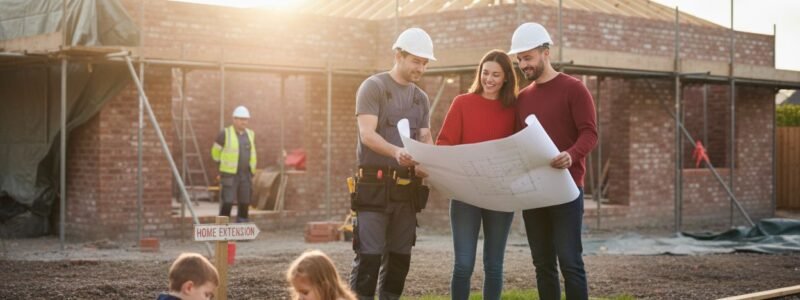Adding a home extension is one of the biggest investments a homeowner can make, with well-maintained improvements increasing property value by up to 15 percent. Most people think the hard work ends once the builders leave and the dust settles. But that is when the real challenge begins and home extension aftercare steps in to protect your space for years to come.
Table of Contents
- What Is Home Extension Aftercare?
- Why Is Aftercare Important For Home Extensions?
- How Home Extension Aftercare Works: Key Concepts
- Common Challenges In Home Extension Aftercare
- Best Practices For Maintaining Your Home Extension
Quick Summary
| Takeaway | Explanation |
|---|---|
| Implement regular professional inspections | Schedule annual assessments to identify potential structural issues early before they escalate. |
| Adopt proactive maintenance protocols | Develop a structured plan to address minor repairs and environmental protection regularly. |
| Document all maintenance activities | Keep detailed logs of inspections, repairs, and interventions for future reference and effective management. |
| Understand material-specific care requirements | Different materials require unique maintenance approaches; know how to care for each type effectively. |
| Protect against environmental degradation | Monitor environmental factors like moisture and UV exposure to maintain the extension’s integrity. |
What is Home Extension Aftercare?
Home extension aftercare represents a comprehensive approach to maintaining and protecting your newly expanded living space after construction is complete. Unlike traditional renovation practices that conclude at project handover, aftercare involves strategic monitoring, maintenance, and proactive management to preserve the structural integrity, aesthetic quality, and long-term performance of your home extension.
Understanding the Aftercare Concept
Aftercare goes beyond simple post-construction maintenance. It is a systematic process designed to ensure your home extension continues functioning optimally, remains structurally sound, and maintains its value. Our project management guide offers deeper insights into this comprehensive approach.
The aftercare process typically involves several critical components:
To clarify the different facets of aftercare, the following table compares the key components of home extension aftercare and their purposes.
| Component | Purpose |
|---|---|
| Comprehensive Initial Inspection | Establishes construction quality baseline and identifies immediate post-completion issues |
| Scheduled Maintenance Checks | Helps detect emerging problems and supports routine upkeep |
| Addressing Settlement and Adjustments | Manages natural settling and material shifts to preserve structural stability |
| Warranty and Guarantee Management | Ensures eligibility for repairs within coverage periods and maintains protection |
| Monitoring Wear and Performance | Identifies deterioration early, supporting timely intervention and repair |
- Comprehensive initial inspection of completed work
- Scheduled maintenance checks
- Addressing potential settlement or structural adjustments
- Managing potential material and workmanship warranties
- Monitoring potential wear and performance issues
Why Aftercare Matters
Professional aftercare is crucial because home extensions represent significant financial and emotional investments. According to UK Home Improvement Research, proper post-construction maintenance can prevent potential structural issues, reduce long-term repair costs, and maintain the property’s overall value.
By implementing a structured aftercare strategy, homeowners can:

- Protect their substantial financial investment
- Prevent minor issues from escalating into major problems
- Ensure the extension meets all structural and safety standards
- Maintain the aesthetic and functional quality of the new space
Understanding and implementing a robust home extension aftercare approach transforms your project from a simple construction job into a long-term, sustainable home improvement strategy.
Why is Aftercare Important for Home Extensions?
Aftercare is fundamental in protecting your substantial investment in home extensions, ensuring long-term structural integrity, performance, and aesthetic appeal. The importance of a structured aftercare approach extends far beyond simple maintenance, representing a strategic investment in your property’s future value and functionality.
Financial Protection and Value Preservation
Home extensions represent significant financial commitments, often costing tens of thousands of pounds. Our extension inspiration guide highlights the transformative potential of these projects. According to UK Property Research, well-maintained home improvements can increase property value by up to 15%.
Key financial benefits of comprehensive aftercare include:
- Preventing costly structural repairs
- Maintaining extension warranty validity
- Protecting property market value
- Reducing long-term maintenance expenses
Structural Integrity and Performance Monitoring
Home extensions undergo natural settlement processes and material interactions that require careful monitoring. Structural shifts, material expansions, and environmental interactions can compromise extension quality if not professionally managed.
Critical performance monitoring aspects include:
- Detecting early signs of structural movement
- Assessing thermal performance and insulation effectiveness
- Checking waterproofing and moisture resistance
- Evaluating joint and connection stability
Long-term Quality and Aesthetic Maintenance
Beyond structural considerations, aftercare ensures your home extension maintains its original design intent, aesthetic quality, and functional performance. Regular professional assessments help preserve the craftsmanship, material integrity, and visual appeal of your investment.
Proactive aftercare strategies protect your extension against common degradation factors such as material fatigue, environmental stress, and potential construction imperfections, ultimately safeguarding your home improvement vision.
How Home Extension Aftercare Works: Key Concepts
Home extension aftercare operates as a systematic approach to maintaining and monitoring your newly constructed living space, integrating proactive strategies that protect your investment and ensure long-term structural performance. Understanding the underlying mechanisms helps homeowners effectively manage their extension’s ongoing quality and functionality.
Comprehensive Assessment and Documentation
Our project management workflow guide emphasizes the critical nature of systematic documentation. According to Construction Industry Research, successful aftercare begins with detailed initial documentation that serves as a baseline for future monitoring.
Key documentation components include:
- Comprehensive initial construction photographs
- Detailed structural blueprints
- Material specification records
- Initial quality assessment reports
- Warranty and guarantee documentation
Periodic Professional Inspection Processes
Aftercare involves structured, professional inspections designed to identify potential issues before they escalate. These assessments go beyond visual checks, incorporating specialized techniques to evaluate structural integrity, material performance, and potential environmental interactions.
Critical inspection focus areas encompass:
- Foundation and structural settlement analysis
- Thermal performance evaluation
- Moisture and waterproofing assessments
- Material degradation monitoring
- Joint and connection stability checks
Proactive Maintenance and Intervention Strategies
Successful home extension aftercare transforms reactive repair approaches into proactive maintenance strategies. By anticipating potential issues and implementing timely interventions, homeowners can prevent minor problems from developing into significant structural challenges.
This approach involves continuous monitoring, regular professional assessments, and a commitment to maintaining the extension’s original design quality and functional performance. Proactive aftercare ensures your home extension remains a valuable, structurally sound, and aesthetically pleasing investment for years to come.

Common Challenges in Home Extension Aftercare
Home extension aftercare presents numerous complex challenges that require strategic understanding and proactive management. These challenges emerge from intricate interactions between construction materials, environmental conditions, structural dynamics, and ongoing property usage.
Structural Settlement and Material Interactions
Our comprehensive step-by-step home extension guide highlights the nuanced nature of structural dynamics. According to Structural Engineering Research, home extensions experience continuous micro-movements that can compromise long-term integrity if not professionally monitored.
Key structural settlement challenges include:
- Natural building material expansion and contraction
- Ground movement and foundation stress
- Joint and connection point vulnerabilities
- Temperature and humidity induced structural shifts
- Differential settling between original structure and extension
Environmental and Performance Degradation
Home extensions are constantly exposed to environmental stressors that can gradually compromise their structural and aesthetic quality. These challenges require comprehensive, systematic monitoring to prevent incremental damage and maintain optimal performance.
Critical environmental degradation factors encompass:
- Moisture penetration and potential water damage
- UV radiation impact on material integrity
- Thermal performance fluctuations
- Wind and atmospheric pressure interactions
- Potential material fatigue and erosion
Maintenance and Professional Intervention Complexities
Successful aftercare demands sophisticated understanding of potential degradation mechanisms and timely professional interventions. Homeowners must navigate complex maintenance requirements, balancing proactive monitoring with strategic professional assessments.
Effective aftercare requires recognizing subtle performance changes, understanding material science principles, and implementing targeted maintenance strategies.
This table summarises common challenges encountered in home extension aftercare, along with a concise explanation for each issue.
| Challenge | Explanation |
|---|---|
| Structural Settlement | Micro-movements and differential settling can lead to cracks and long-term instability |
| Material Expansion and Contraction | Temperature and humidity changes cause materials to shift, affecting finishes and structural joints |
| Moisture and Environmental Exposure | Water ingress, UV rays, and atmospheric conditions degrade structural and aesthetic features |
| Maintenance Complexity | Unique extension materials require specialised knowledge for proper care and intervention |
| Warranty and Compliance Management | Navigating warranties and legal standards necessitates ongoing documentation and vigilance |
Best Practices for Maintaining Your Home Extension
Maintaining a home extension requires a strategic, holistic approach that combines preventative care, professional monitoring, and proactive intervention. Successful maintenance goes beyond simple repairs, focusing on preserving structural integrity, aesthetic quality, and long-term performance.
Regular Professional Inspections
Our modern extension design guide emphasizes the importance of systematic professional assessments. According to Building Maintenance Research, structured inspections are crucial in identifying potential issues before they escalate.
Key professional inspection strategies include:
- Annual comprehensive structural assessments
- Detailed thermal performance evaluations
- Moisture and waterproofing systematic checks
- Material integrity and degradation monitoring
- Joint and connection stability analyses
Proactive Maintenance Protocols
Effective home extension maintenance requires a systematic approach that anticipates potential challenges and implements targeted interventions. Homeowners must develop comprehensive maintenance protocols that address the unique characteristics of their specific extension.
Critical proactive maintenance components encompass:
- Regular cleaning and surface protection
- Immediate addressing of minor structural shifts
- Maintaining appropriate internal temperature and humidity levels
- Protecting against environmental degradation
- Monitoring and maintaining material-specific care requirements
Documentation and Continuous Learning
Successful home extension maintenance involves meticulous documentation and a commitment to ongoing learning about your specific construction. By maintaining detailed records and understanding the unique characteristics of your extension, homeowners can make informed maintenance decisions.
This approach requires creating comprehensive maintenance logs, tracking professional inspection reports, documenting any repairs or interventions, and staying informed about emerging maintenance technologies and techniques. Continuous engagement and proactive management ensure your home extension remains a valuable, structurally sound investment for decades.
Safeguard Your Home Extension with Expert Aftercare and Professional Guidance
Completing a home extension is only the beginning. Many homeowners feel uncertain about maintaining their new space and worry about structural shifting, undetected issues, and protecting their investment for the long term. Our article highlights the importance of proactive aftercare, regular professional inspections, and comprehensive project documentation. If you value peace of mind and want to keep your extension in excellent condition, the right specialist support makes all the difference.
At Reltic Extend, we not only build bespoke extensions tailored for London and Surrey properties, but also offer robust project management solutions to help you manage your aftercare journey. Let our 20 years of experience and commitment to quality take away the stress of upkeep. Do you want your extension to remain safe, compliant, and visually impressive? Reach out through our contact page and explore our full range of extension types and ideas to see how our expertise can protect your dream space starting today.
Frequently Asked Questions
What is home extension aftercare?
Home extension aftercare is a systematic process designed to maintain and protect your newly expanded living space after construction. It involves monitoring, maintenance, and management to ensure the structural integrity, aesthetic quality, and long-term performance of your extension.
Why is aftercare important for home extensions?
Aftercare is crucial for safeguarding your financial investment in home extensions. It helps prevent costly repairs, maintains the property’s market value, and ensures that safety and structural standards are met over time.
How does aftercare work for home extensions?
Aftercare involves comprehensive assessments, scheduled inspections, and proactive maintenance strategies. It requires initial documentation of the construction, regular professional inspections, and timely interventions depending on the condition and performance of the extension.
What are common challenges in home extension aftercare?
Common challenges include managing structural settlement, addressing environmental degradation, and navigating maintenance complexities. These issues can arise from natural material interactions, exposure to environmental stressors, and the need for professional assessments for timely interventions.





